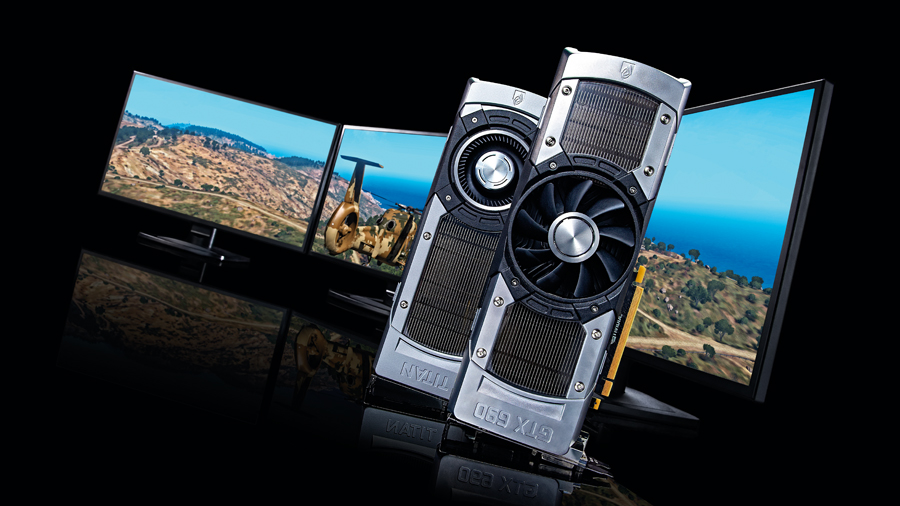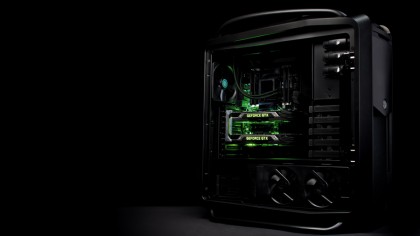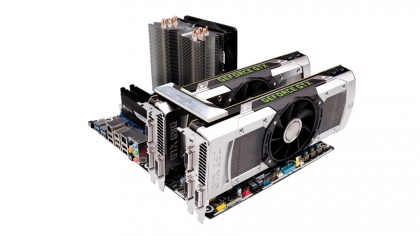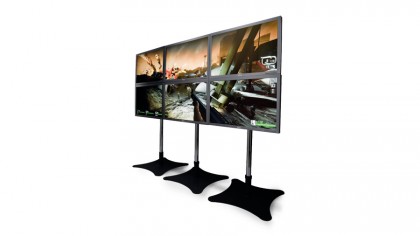Best high resolution and multi GPU graphics cards: 10 reviewed
One GPU or two? That is the question

Want to justify that £829 graphics card you just bought? Need to figure out how to drive that massive-o-screen that almost melted your credit card? Well, the only realistic answer is either incredibly high-resolution gaming or going for a multi-GPU setup that might melt your PSU, as well as your personal wealth.
The thing is, despite the fact that graphical hardware has evolved at an astounding rate over the last few years, panel and game technology hasn't really kept up. Since the last generation consoles came around, most of us have been aiming for 1080p resolutions.
At first that was a laudable goal and it felt like an age before it became the standard res. But now it is, with the Steam hardware survey claiming around a third of users have a primary display running at 1,920 x 1,080. At that resolution, even sub-£100 graphics cards are more than capable of running most new titles on relatively high settings, at playable frame rates.
To really push your modern midrange/high-end graphics cards you need to up the resolution and, sadly, the 30-inch panels of the last five years - with their 2,560 x 1,600 resolutions - are still at the top of the tech tree, knocking around the £1,000 mark. There are 27-inch screens with the 16:9 res of 2,560 x 1,440, and these are probably your best bet for high-res gaming on a relatively sensible budget.
The next step up is to strap a bunch of screens together in some sort of widescreen surround setup. We're talking about resolutions of around 5,880 x 1,080 when you're linking up three 1080p screens in landscape mode with bezel correction. And with those extra pixels filling up your eyes you may actually need a second GPU just to cope with it all.
When I started this whole long-winded testing process, I was of the opinion that the square peg of surround screen gaming was struggling to fit into the same round hole as 3D. I thought both were resource-intensive frame rate hogs - limiting the fidelity of your game, without adding much to your experience.
And to be honest, that opinion hasn't changed. You need some incredible graphical grunt to get the most out of a triple-screen array, and for the most part that means selling your soul to the dark god of multi-GPU gaming.
Sign up for breaking news, reviews, opinion, top tech deals, and more.

Beware, though - that way madness lies. The resolutions involved in multi-screen arrays in-game put huge demands on your available GPU power, but as we start to tread the seemingly long dirt track to 4K gaming, maybe this is something that we need to start thinking about seriously.
Strapping a few monitors to a couple of GPUs is the only realistic way for us to achieve resolutions above what our blessed 30-inch Dell panel can render, which is the only way to really put the latest and greatest graphics chips through their high-res paces.
As an exercise in seeing just how far we can push the modern GPUs of this generation - and seeing how close we are to machines capable of 4K gaming - the high resolutions involved in surround screens setups are useful. But as a gaming experience right now, they're simply an indulgence, with a huge amount of wasted screen real estate and a massive premium placed on frame rates.
The whole deal with surround screen gaming is to have a wrap-around view of your game world, with a pair of panels either side of a central screen essentially acting as your peripheral vision. If extra screens were given away - and the frame rate hit wasn't effectively halving performance - then it would be a neat extra to have, adding a little immersion to your experience.
But that isn't the way of surround gaming. At best you're looking at screens around the £100 mark, so you're adding another £200 to your gaming setup for a pair of panels that, by definition, you're not actually meant to be looking at. The distorted images stretched out over the peripheral screens aren't pretty, but are there to catch the corner of your eye while you're focusing most of your attention on what's happening right in front of you.
In a first-person shooter, that kind of widescreen vision can be useful to see who's creeping up on you, and in racing games it certainly adds to the sensation of speed, but it rarely offers a proper, tangible benefit. Having an extra screen is neat, but definitely not enough to justify such a chunky outlay.
The woes of setup

And then there's the setup anguish. Getting three screens running simultaneously can be something of a chore, although my initial experiences were relatively positive. I began my testing slog with the Nvidia cards, with each and every one of the five different setups immediately recognising the three 1080p DVI screens. This allowed me to either spread the connections across the cards in the multi-GPU sets, or run all three from a single card with the Titan and GTX 690.
Getting the desktop spread across the triple-screen array was simple too, dipping into the Nvidia Control Panel and adjusting bezel correction and the like in a trice.
The AMD cards, those champions of multi-monitor gaming through the Eyefinity initiative, were more of an abject lesson in setup anxiety. For reasons best known to itself, AMD is obsessed with DisplayPort.
This obsession means that if you want to run three screens from its cards, then one of those monitors has to be running from one of the DisplayPort connections on the first card in the array. With our DVI screens that proved a bit of a stumbling block to say the least.
With the Nvidia cards, we could cope with a lack of DVI connectors on a single card by spreading the load across an SLi pair - something that's not possible in CrossfireX. So it's a case of adapt or fail, usually requiring one screen to be attached via a DVI cable, another via an HDMI adaptor, and the third and final displayPort-hungry screen via a DP adapter.
This would be simple were it not for the fact there are both active and passive adaptors available for DisplayPort, and it can be hard to know which are capable of actively altering the clocks in the adapter so the card thinks it's powering a DP monitor. With a passive adaptor you'll only ever get two screens running at a time.
Thankfully, Sapphire was good enough to provide us with a functioning option after two failed attempts by our IT bods and a long trawl around the city trying to track one down locally.
So, Nvidia is the king of multiscreen setups, with its ease of use and the fact that it doesn't rely on DisplayPort to make up the full, surround screen array. But given the extra expense involved and the lack of tangible benefits, we're really straying into the kingdom of the blind here.
Size matters

The fact remains, then, that if you want the best high-res experience, you need to buy the biggest monitor you can. You can pick up a decent 27-inch panel running at 2,560 x 1,440 for less than £500, but the 30-inch 16:10 panels are still prohibitively pricey.
A larger single monitor can also be run more readily from a single GPU, meaning you don't have to suffer from the woes of multi-GPU setups. Even a single HD 7870 XT, for example, will run pretty much everything at playable speeds at 2,560 x 1,440.
Still, our tests have shown that very high-res gaming is certainly not out of the reach of today's hardware. We may not have quite got to the levels of full 4K with our multi-screen array, but we're not far off and with some decent performance from current silicon.
That's lucky as AMD's current generation of GPU is going to be driving the hardware of the gaming future in the next-gen consoles - and for them, the 4K roadmap is vital.
On the next page we review the GPU set-ups.